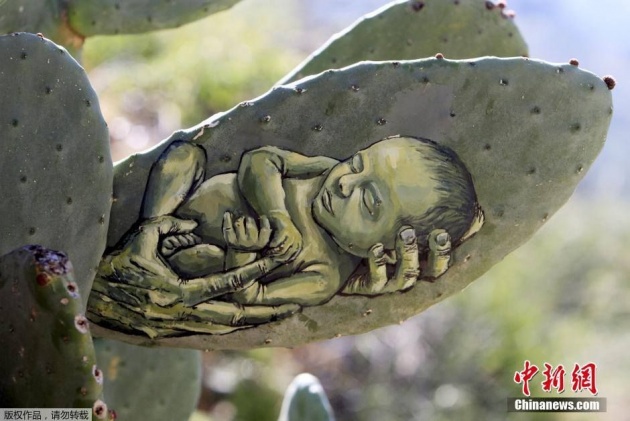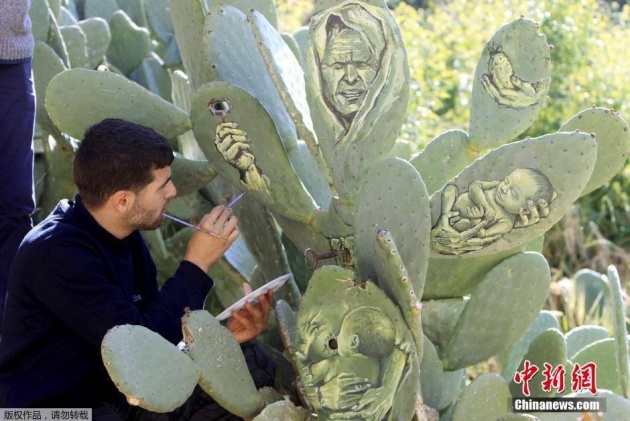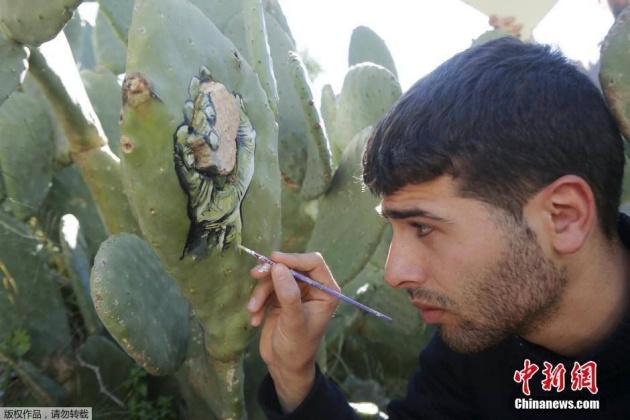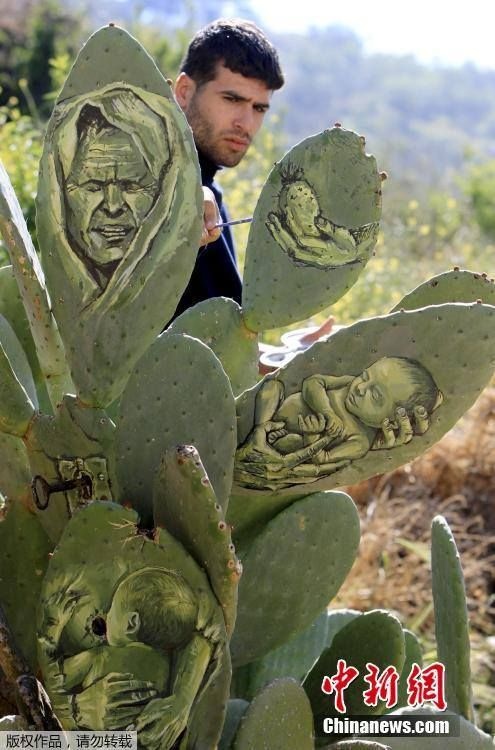Cactus painting by Palestinian artist Ahmad Yaseen

For Pakistani artist Ahmad Yaseen, spiny cactus plants make perfect canvas for his drawings. The artist has impressed many by his original way of expressing Palestinian suffering: using something that no one had contemplated.
Rather than painting scenes from the ongoing conflict between Israelis and Palestinians, Yaseen draw elements that provide glimmer of hope. His favorite set of drawings is of two newborns – one is resting in his mother’s arms while the other is breastfeeding.
Cactus painting by Palestinian artist Ahmad Yaseen
About a year ago, Yaseen decided that the cacti growing in and around his village would become his canvases, and he would use those plants to accurately depict what the Palestinians are going through, how they live.Just see inner meaning of this painting they just want to show the other countries small kids are not safe in Palestine,Shame on Israeli cows.

Israel is the terrorist and primitive state to have emerged in the world. Those who think Israelites are the God's favorite nation he must be a thousand stupid. They do oppress and kill Palestinian children, the only nation still practising colonialism and land alienation thinking Palestine will agree everything. Regardless the extreme blutality and force they use to defenceless Palestinians citizens backed UN,EU,NATO,&USA. They will never live in peace forever unless Palestine become free.
What a meaning of inner of this painting...That incredible..! Painter just show Palestinians kid are danger by Israel.
show the real face of Israeli jews to the world. So that every nation shall be able to see the real terrorists. Israelis are the real terrorists. Their aim is just destroy the muslims. Muslims kids and women are the main victims.
And what are Palestinians doing ? Do the world not know. Where they are, the world is suffering. Either it is Kashmir, Israel, or any other country. The whole world is suffering from tsrrerorism. And the world know who doing so. And I think every country have right to secure their country and citizens

Really? Beautiful? there's a carving if a terrorist murderer holding a knife.Another a stone.Terrorism is inexcusable!Seems to go hand in hand with islamic politics.From suicde vests to stones.Stabbing pregnant women on a bus in Israel or blowing up an airport in Brussles.It's islam every time.This kind of post is disgusting and glorifies cowardly acts.Stop calling evil good and good evil

I am sending you a free link of the world best and genuine online marketing company. In just 14 days video tutorial programe your life is changed its my promise.
Ahmed Yassin was born in 1938 in the destroyed village of Al-Joura, Majdal district, near the present-day Zionist town of Ashkelon — or Askalan in Arabic. Yassin’s father died when he was five years old.
The young Ahmed Yassin joined Al Jora elementary school and continued studying there till the fifth grade until 1948. In 1948 Nakba or the usurpation of most of Palestine at the hands of Zionist gangs the young Yassin was forced to flee at the age of 12 along with his family and thousands of other refugees southwards to the Gaza Strip after Zionist forces overran his village and threatened to kill its inhabitants. This nightmarish experience seems to have had a particularly strong impact in shaping the psychological build-up of a boy who would later become one of the Zionists most trenchant enemies. His birthplace was bulldozed, along with nearly 500 other Palestinian towns and villages in 1948, following the occupation of Palestine.
Yassin who survived the Palestinian Disaster (Al Nakba) of 1948 learned an important lesson that impacted his intellectual and political life forever, a lesson that says Palestinians can only depend on themselves and arm their people without depending on other nations or the international community.
Education
Yassin graduated from secondary school in the year 1957/1958 and managed to get a job as a teacher despite objection to his health condition. In 1959 he went to Egypt where he spent some time studying at Ain Shams University. There he received a college diploma and, more importantly, was deeply influenced by the ideas of the Muslim Brotherhood.
In 1962, shortly after his return to Gaza, Yassin was briefly detained by the Egyptian authorities in connection with his activities within the Muslim Brotherhood in opposition to the regime of then Egyptian President Gamal Abdel-Nasser. He was put in a solitary confinement cell for a month, until he was released after he was proved not to be involved with the Brotherhood. His detention period affected him significantly, and “rooted the hate of injustice” in his soul, as he said in an interview.
Work under the life of agony:
In Gaza things changed and he and his family lived the life of refugees, similar to most of the Palestinians at that time, tasting the bitter feelings of hunger and deprivation. He used to go to the Egyptian army camps near Gaza to gather the soldiers’ leftovers and go back with it to his family.
Yassin quit school between 1949-1950 to support his seven-member family working in one of the restaurants in Gaza, and then returned back to school. In 1952, Yassin was injured while playing sport, leaving him a quadriplegic for the rest of his life. However, paralysis did not put an end to his ambitions. He worked as an Arabic and religion teacher and later a preacher in the Gaza mosques. He turned into one of the most vociferous and most famous Khatibs in the Gaza Strip following its occupation in 1967.
Political life
In his 20’s, Yassin participated in the demonstrations that broke out in Gaza to denounce the 1956 tripartite aggression on Egypt, and showed immense public speech and political intellect . He became actively involved in the calls opposing to an international supervision over Gaza, stressing the need to regain Egyptian administration on the lands again.
Working as a preacher in Gaza allowed him to spread the MB ideas and to gather hundreds of supporters who later came to form the nucleus of Hamas. The message he spread was that the loss of Palestine in 1948 was merely a symptom of the stagnation of the Islamic Ummah. The solution he demanded lay in the reinstatement of Islam as a unifying political force by overthrowing all existing Arab secular regimes which he described as un-Islamic or anti-Islamic.
After the 1967 war, in which the Zionists occupied all the Palestinian territories including the Gaza Strip, Sheikh Ahmed Yassin continued inspiring the Muslims and Palestinians from the Al Abbasi Mosque’s rostrum, calling to the resistance of the occupation. He turned into one of the most vociferous and most famous preachers in the Gaza Strip following its occupation in 1967. At the same time he was involved in gathering donations to help the families of the martyrs and prisoners, later to work as a president of the Islamic Complex in Gaza.
Sheikh Yassin follows the principles and ideology of the Islamic Brotherhood that was established in Egypt in 1928 by the Imam Hassan Al Banna.
Yassin Began to Work with Mujahedin
In 1982, Yassin started to form local resistance cells under the code name Majd, with the help of some prominent Muslim Brotherhood figures in Jordan who financed his weapon purchases. Soon afterwards the Zionist occupation authorities found out and Yassin was arrested and sentenced to 13 years in prison for forming a resistance group and possessing “illegal” weapons. He also worked as a chairman of the Islamic Complex in Gaza before his arrest in 1984
In 1985 he was released from Zionist custody as part of a prisoner swap between the Zionist entity and the Popular Front for the Liberation of Palestine General Command, headed by Ahmed Jebril.
The Sheikh Founded Hamas -1987
After his release, Sheikh Ahmed Yassin founded the Islamic Resistance Movement (Hamas) in mid-1987, along with a group of Islamic leaders including Dr. Abd al Aziz al Rantissi in the Gaza Strip. Hamas' aims are to resist the Zionist occupation in order to liberate historical Palestine. Hamas had a significant role in the Palestinian Intifada that broke out at that time, and was known as “the revolution of the mosques”. Since that time, Sheikh Yassin was considered the spiritual leader of the movement. Hamas carried out a number of effective attacks mainly on Zionist occupation troops in the Gaza Strip, killing a number of Zionist occupation soldiers and officers.
Arrested again
As the Intifada stepped up its momentum against the Zionist occupation, the Zionists began to think of means to stop Yassin’s activities, so Zionist soldiers raided his home on August 1988, searched it and threatened him of punishment to Lebanon.
In 1989, two years into the first Intifada, Yassin was again arrested by Zionist occupation authorities. This time he was sentenced to 40 years in prison, charged with calling to armed resistance and charges of inciting to kill and kidnap Zionist occupation soldiers as well as founding of Hamas movement and its military wing.
Disease but No ReleaseYassin spent nearly eight years in jail where he suffered a number of other disabilities and diseases including loss of eyesight in his right eye due to Zionist blows during round of interrogations, in addition to weakness in his left eye, as well as chronic otitis and lung allergy, also caused by harsh detention conditions in the Zionist jails. He also suffered from chronic inflammation in his ear, lung infection and other stomach diseases.
On 13/12/1992 a commando cell affiliated with the Qassam Brigades, military wing of Hamas, kidnapped a Zionist soldier and offered to set him free in return for the release of Sheikh Ahmed Yassin and a number of other detainees in Zionist jails including sick and elderly Arab captives. However, the Zionist government refused the offer and stormed the house where the soldier was held leading to his death along with commander of the attacking unit and two other soldiers before the martyrdom of the three members of that cell in Bir Nabala near occupied Jerusalem.
Cactus painting by Ahmed Yassin احمد ياسين with Oud Music by Bassem Kadmani
Released by Fate but it was not too late
In 1997, Yassin was freed from prison after the late King Hussein of Jordan insisted that the Zionist government of Benyamin Netanyahu release him in exchange for the release from Jordanian custody of two Mossad agents who carried out an unsuccessful assassination attempt on Khaled Meshaal, the head of the Hamas contingency in Amman. Yassin’s subsequent triumphant return to Gaza significantly enhanced Hamas’ status and granted the movement the position of “second among equals” vis-a-vis the Palestinian Authority.
.Yassin and Oslo Accords
Yassin vehemently opposed the Oslo Accords, which he viewed as a “disgraceful capitulation” and “great deception”. Indeed, the intensive construction of Jewish settlements in the West Bank and Gaza Strip, along with the continued confiscation by successive Zionist governments of large swathes of Palestinian land, seemed to vindicate his views in the eyes of many Palestinians.
Yassin Rejects the Civil War
Prior to the outbreak of the second Intifada in September 2000, Yassin was placed under house arrest, with severed telephone communications by the PA, which was under tremendous pressure from the United States and the Zionists to “rein in” Hamas and Islamic Jihad. The Hamas leader was always careful not to allow recurrent frictions with the PA which may evolve into some kind of civil war, which he viewed as “the ultimate Palestinian red line”. Believing that a divided leadership would undermine Palestinian interests, Sheikh Yassin sought to maintain good relations with the Palestinian Authority and with other regimes in the Arab world.
Yassin insisted on the Palestinians Right of Peaceful life
During the ongoing Al-Aqsa Intifada, Yassin consistently held fast to the “robe of resistance”. He argued that freedom is earned, not granted on a silver platter, and that which is taken by force can be only recovered by force. He vehemently defended martyrdom bombings against the Zionist entity, explaining that they constituted only weapon available to the Palestinian people in the face of the enemy with far more powerful military capabilities that is hell-bent on exterminating and crushing the Palestinian people. He repeatedly demanded an end to all attacks targeting Palestinian civilians and un-uniformed Zionists. However, the Zionist entity consistently rejected all initiatives to that effect.
The first attempt to assassinate the Sheikh
Thousands of cheering supporters turned out to watch him vow revenge for the first Zionist attempt on his life in September 2003. This was mirror by millions of Muslims worldwide, having sent shock waves and new calls for Jihad throughout the Ummah.
However, for a staunchly ideological movement like Hamas — where the idea is more important than the leader — it is unlikely that Yassin’s death will seriously undermine the movement in any permanent way. In fact, he had already effectively stopped running the movement’s day-to-day affairs several years ago due to his deteriorating health and relatively old age.
Sheikh Yassin lived his life in his humble home in the Al Sabra neighborhood in Gaza City. He survived with minor injuries a failed attempt on his life by the Zionist occupying forces on September 6, 2003 while he was visiting a friend in Gaza. He was only lightly injured in his right arm. Nonetheless, he remained until his death the most effective and eloquent spokesman of Hamas and the entire Palestinian Islamic camp, despite his severe physical disability.



